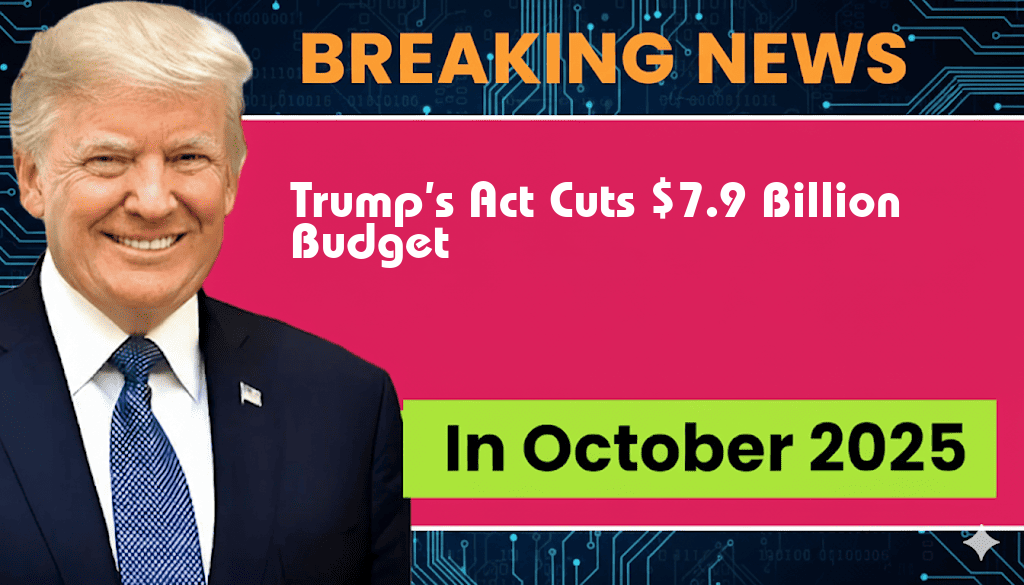Trump’s Rescissions Act Cuts $7.9 Billion from Budget
In a significant move aimed at reshaping federal spending, former President Donald Trump has introduced the Rescissions Act, which seeks to eliminate approximately $7.9 billion from the federal budget. This initiative comes as part of a broader effort to address the growing national debt and streamline government expenditures. The proposed cuts target various programs and agencies that Trump and his administration view as inefficient or unnecessary. The announcement has sparked debate among lawmakers and policy experts, as it raises questions about the potential impacts on essential services and economic stability.
Details of the Rescissions Act
The Rescissions Act identifies specific areas of the federal budget where spending can be reduced without significantly affecting public services. According to sources close to the administration, the cuts are primarily focused on discretionary spending, which includes funding for education, environmental protection, and public health initiatives.
- Education Programs: The act proposes cuts to various educational grants that have not been fully utilized.
- Environmental Initiatives: Funding for certain environmental projects will be reduced, targeting programs deemed less critical.
- Public Health: Some health initiatives that received surplus funding during the pandemic will also see reductions.
Political Reactions
The announcement of the Rescissions Act has elicited mixed reactions from both sides of the aisle. Supporters argue that the bill is a necessary step towards fiscal responsibility, emphasizing that the federal government must tighten its belt in light of rising debt levels. Critics, however, express concern that the cuts could undermine critical services and hurt vulnerable populations.
Senate Majority Leader Chuck Schumer (D-NY) criticized the bill, stating, “This is not the time to slash funding from programs that serve our communities. We need to invest in education and public health, not cut them.” On the other hand, House Speaker Kevin McCarthy (R-CA) praised the act, asserting that it is a “bold move towards reducing wasteful spending and prioritizing taxpayer dollars.”
Economic Implications
Experts are weighing in on the economic implications of the proposed budget cuts. Some economists argue that while reducing federal spending can help control inflation and stabilize the economy, it may also lead to a decrease in overall demand. This, in turn, could stifle economic growth and negatively impact job creation.
| Impact Area | Positive Effects | Negative Effects |
|---|---|---|
| Inflation Control | Reduced spending can help lower inflation rates. | May lead to decreased consumer demand. |
| Job Creation | Potential for increased private sector investment. | Public sector job cuts could rise. |
| Public Services | Encourages efficiency in government programs. | Risk of reduced access to essential services. |
Next Steps for Implementation
For the Rescissions Act to take effect, it must pass through Congress, where it will likely face scrutiny and negotiation. Supporters will need to rally enough votes to overcome opposition from Democrats and some moderate Republicans who are wary of the cuts’ implications. The timeline for a vote remains uncertain, as lawmakers are currently addressing other pressing issues, including potential funding for federal agencies and upcoming budget deadlines.
As debates continue, the administration faces the challenge of balancing fiscal responsibility with the need to support essential services. Observers note that the outcome of this legislative effort could set a precedent for future budgetary measures and the broader conversation about government spending.
For more information on the implications of federal budget cuts, you can visit Forbes and Wikipedia.
Frequently Asked Questions
What is Trump’s Rescissions Act?
The Rescissions Act proposed by Trump aims to cut unnecessary spending from the federal budget, specifically targeting allocations that are deemed no longer needed or effective.
How much money is being cut from the budget?
The Rescissions Act will result in a total of $7.9 billion being cut from various federal budget allocations.
What types of programs are affected by these cuts?
The budget cuts from the Rescissions Act primarily affect domestic programs, including certain social services and federal agency funding that has been identified for reduction or elimination.
What is the intended impact of the Rescissions Act?
The intended impact is to streamline government spending and redirect funds towards more critical areas, while also addressing the national deficit.
Has the Rescissions Act been approved?
As of now, the Rescissions Act is still under consideration and has not yet been fully approved by Congress, meaning the cuts are not yet finalized.

Leave a Reply